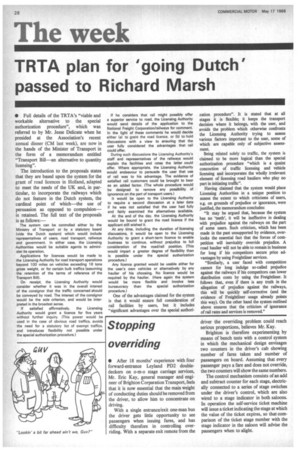The week
Page 30

If you've noticed an error in this article please click here to report it so we can fix it.
TRTA plan for 'going Dutch' passed to Richard Marsh
• Full details of the TRTA's "viable and workable alternative to the special authorization procedure", which was referred to by Mr. Jesse Delicate when he presided at the Association's recent annual dinner (CM last week), are now in the hands of the Minister of Transport in the form of a memorandum entitled "Transport Bill—an alternative to quantity licensing".
The introduction to the proposals states that they are based upon the system for the grant of road licences in Holland, adapted to meet the needs of the UK and, in particular, to incorporate the railways which do not feature in the Dutch system, the cardinal point of which—the use of
persuasion as opposed to compulsion— is retained. The full text of the proposals is as follows:— The system can be controlled either by the Ministry of Transport or by a statutory board (vide the Dutch system) which would include representatives of users, road transport, railways and government. In either case, the Licensing Authorities would be suitable agents to administer its operation.
Applications for licences would be made to the Licensing Authority for road transport operations beyond 100 miles on vehicles exceeding 16 tons gross weight, or for certain bulk traffics (assuming the retention of the terms of reference of the Transport Bill).
On receipt. the Licensing Authority would consider whether it was in the overall interest of the consignor that the traffic concerned should be conveyed by road. The interest of the consignor would be the sole criterion, and would be interpreted in the broadest sense.
If satisfied affirmatively, the Licensing Authority would grant a licence for five years without further inquiry. (This power would be used in the case of obvious road traffics, avoids the need for a statutory list of exempt traffics, and introduces flexibility not possible under the special authorization procedure.) If he considers that rail might possibly offer a superior service to road, the Licensing Authority would send details of the application to the National Freight Corporation/railways for comment. In the light of these comments he would decide either (a) to grant the road licence, or (b) to hold discussions with a view to ensuring that the user fully considered the advantages that rail could offer.
During such discussions the Licensing Authority's staff and representatives of the railways would explain the facilities and rates the latter could offer. Where appropriate, the Licensing Authority would endeavour to persuade the user that use of rail was to his advantage. The evidence of satisfied rail customers could be brought to bear as an added factor. (The whole procedure would be designed to remove any possibility of ignorance on the part of transport users.) It would be open to the Licensing Authority to require a second discussion at a later date if he was not satisfied that the user had fully and fairly examined the alternatives available.
At the end of the day, the Licensing Authority would be bound to grant the road licence if the applicant still wished it.
At any time, including the duration of licensing discussions, it would be open to the Licensing Authority to grant a short-term licence to enable business to continue, without prejudice to full consideration of the road/rail position. (This would impart a greater degree of flexibility than is possible under the special authorization procedure.) Any licence granted would be usable either for the user's own vehicles or alternatively by any haulier of his choosing. No licence would be required by the haulier. (Here again the system would be more flexible and involve less bureaucracy than the special authorization procedure.)
One of the advantages claimed for the system is that it would ensure full consideration of rail facilities by users, but it includes "significant advantages over the special authori zation procedure". It is stated that at all stages it is flexible; it keeps the transport decision where it belongs, with the user, and avoids the problem which otherwise confronts the Licensing Authority trying to assess various factors important to the user, some of which are capable only of subjective assessment.
Being related solely to traffic, the system is claimed to be more logical than the special authorization procedure "which is a quaint concoction of traffic licensing and vehicle licensing and incorporates the wholly irrelevant element of licensing road hauliers who play no part in initiating traffic".
Having claimed that the system would place Licensing Authorities in a unique position to assess the extent to which criticisms of users, e.g. on grounds of prejudice or ignorance, were justified, the memorandum concludes: "It may be argued that, because the system has no 'teeth', it will be ineffective in dealing with prejudice against the railways on the part of some users. Such criticism, which has been made in the past unsupported by evidence, overlooks the essential fact that the forces of competition will inevitably override prejudice. A road haulier will not be able to remain in business for long if his competitors secure price advantages by using Freightliner services.
"Similarly, a user faced with competition cannot for long indulge so-called prejudice against the railways if his competitors can lower distribution costs by using the Freightliner. It follows that, even if there is any truth in the allegation of prejudice against the railways, this will be quickly self-corrective (and the evidence of Freightliner usage already points this way). On the other hand the system outlined above ensures that the criticism of ignorance of rail rates and services is removed."




























































































































